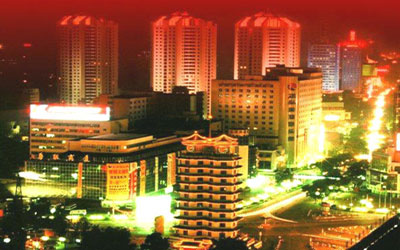Zhengzhou
(china.org.cn)
Updated: 2008-04-29 11:06
Updated: 2008-04-29 11:06
Zhengzhou, located in the Central China plain with the Yellow River to the north and Mount Songshan to the west, is the capital of Henan Province. At the junction of the Beijing-Guangzhou and Lanzhou-Lianyungang railways, it is also the political, economic, cultural, and transportation center of Henan. Zhengzhou is one of the most important textile centers in China, as well as having a well-developed machinery industry.
Zhengzhou has a long history. As early as 3,500 years ago, it became the capital of the Shang Dynasty (Sixteenth - eleventh centuries BC) which together with ancient Egypt, India, and Babylon, was considered to be one of the oldest civilizations of the world.
Today cultural relics and historical sites abound in and around the city, attracting more and more tourists and archaeologists from home and abroad. At Anyang, a town to the north of Zhengzhou, tourists can visit ruins of the Shang Dynasty.
With its lush foliage, Zhengzhou is China's model for the planting of trees in urban areas and is therefore called the "green city."

Henan Provincial Museum of History
This museum in downtown Zhengzhou displays over a thousand cultural relics from Henan Province, together with photographic exhibits. In the exhibition hall, there is a miniature representation of an ancient city, believed to be 3,500 years old, whose ruins were unearthed in Zhengzhou in 1955. It presents a vivid picture of our ancestors smelting metals, making pottery, and polishing bone tools during the Bronze Culture of the Shang Dynasty.
Ruins at Dahe Village
In the autumn of 1964, a site of 300,000 square meters representing the Yangshan and Longshan cultures of the Neolithic Period was discovered at Dahe Village in the northern suburbs of Zhengshou. The ruins of house foundations, dating back five thousand years, show separate inner and outer rooms - indicating that group marriage probably no longer existed and that families in which young couples lived separately from their parents had appeared.
Ruins of an Ancient City of the Shang Dynasty
These ruins cover an area of 25 square kilometers in downtown Zhengzhou. In 1955, a city wall of seven kilometers was discovered on the site. Archaeologists have found ruins of house foundations, cellars, water wells, ditches, and graves. Ornaments and tools made of bronze, stone, bone, shell, and jade were found on the site, as well as pottery and primitive china. Outside the walls, the ruins of various workshops were discovered, among which were foundries for smelting bronze and workshops for making pottery and for polishing bone articles.
These archaeological finds in Zhengzhou provide valuable materials for the study of Shang Dynasty society, particularly with regard to the formation and development of ancient cities in China.
Ancient Tomb at Dahu Pavilion
One of the largest graves of the Han Dynasty (206 BC - AD 220) can be found in suburban Zhengzhou. It is a brick and stone structure in the shape of a covered boat. In addition to the main hall where the coffin was placed, there were a west, a middle, and a small dist room. The walls and ceilings of the grave chambers are covered with paintings and stone carvings that reflect the life of the deceased. Depicting such scenes as rent collection, cooking and dining, hunting, traveling in carts and on horseback, and singing and dancing, they provide valuable data for historical research into the politics, culture, and economy of the Eastern Han Dynasty.
February 7 Memorial Towers
These twin towers, sixty-three meters high, stand in the center of the city. They have three levels at the bottom and nine levels on the upper structure. They were built in memory of a railway worker's strike that started in Zhengzhou on February 4, 1923, and spread to the entire Beijing-Hankou line. On February 7, Wu Peifu, a warlord, ordered his soldiers to fire on the strikers, killing several Chinese Communist Party members and trade union leaders.
|
||
|
||
|
|
|
|